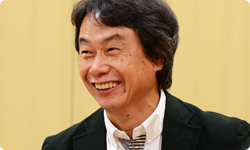So the original form of Nintendo 3DS Guide: Louvre has been available for rent at the museum since last April, and is now available as paid download-only software. Are there any added features?
We were able to add some things that had been cut from the museum guide version into the version available for sale. We had made a lot of different functions for the original guide, but since visitors to the museum only have the devices for a few hours, we felt it was just too much information for such a short period of time.
That have been pointed out during development, and there had been a course change partway to make it strictly a guiding software for use on location. So in the product version there are features that didn’t make it into the version being used at the Louvre.
That’s right. So in the downloadable version there are features where it can automatically generate a tour for you, and it can act as a photo stand with a clock where it will display photos of the exhibits and the art pieces randomly. There’s also the ability to automatically play through all of the information of every exhibit and select and view any one you like. So there’s a lot to enjoy as just a standalone product.
To put it another way, you didn’t cut anything out.
Right. If you bring this software to the museum, you can also use the location detection functionality that’s setup throughout the Louvre. We’ve also got all of the things for kids too, like a tour with quizzes. For people using a wheelchair, the guide can show you all the routes using elevators and lifts. You’ll be able to enjoy the Louvre for days! (laughs)
Listening to the guide and learning everything is so much fun, it just makes you want to learn even more.
That’s true. The original explanations in the audio guide were made in France, so they do have that French flair to them.
Yes.
For example, it begins with “Please listen carefully. Match the rhythm of my footsteps as you walk.” Then you hear the sound of footsteps walking down the hall, and if you match them, you arrive just at the time when the footsteps end. Of course people have different walking speeds, but we were told, “You mustn’t take that part out.” (laughs)
Ah, so that part was very important.
The translation in the Japanese version was focused so it accurately portrayed and respected the original academic descriptions, so there are parts that sound a bit unnatural. We felt like changing some of these translations so they could be more easily understood in Japanese, but we honoured and prioritised their translations, which were based on an academic perspective, when we were told, “You can’t change it that easily!” (laughs)
I see.
Because the explanations were scientific, we would have had to inquire with specialists of that field and have them re-review any changes we wanted to make. But for the download version we’re selling in Japan, we got permission to change some of the Japanese explanations that will only be included in the download.
By the way, how did you do the 3D scanning used in the 3D photos of the statues?

There are various types of scanners. The easiest way using the latest available technology was to use a handheld scanner and scan the statues that way. For the larger statues, we used a stepladder and scanned from directly above the statues. Then we put textures on the models we made to make the 3D models look like the originals. The 3D designers had the task of perfectly matching the 3D models with pictures of the real thing.
But I’m sure there were also some works that were difficult to photograph, right? Things that you couldn’t move, or couldn’t take out of a glass case…
That’s true. We couldn’t take photos of something in a glass case unless we opened the case, but it’s not an easy thing to open those cases, because even the humidity is regulated to preserve the works inside.
And you wouldn’t want to accidentally break something.
The same goes for the larger statues – you don’t want any accidents to happen. So what we did was scan a real-size replica that was moulded off of the original and then touched up the details based on the real thing.
Oh, I see.
Yes. The data is for use in this software, but since it’s a 3D model, if we put the framework in, we could do things like have a warrior statue swing his sword.
What? He can swing his sword?
No, you can’t do that in the software. I wanted to, but understandably, they told us no. (laughs)

(laughs)
So actually, we could have made the Nike of Samothrace flap her wings. We’ve got the materials to do that, as long as we get the Louvre’s permission…
When it goes that far, it’s like a Hollywood movie.
I’d love to be able to work on motions like that someday.
That’s your new ambition! (laughs)
I have so many. There are a lot of theories about the missing arms of the Venus de Milo23, right? I said, “Let’s create all of those,” but I was told, “No, because we don’t have conclusive proof of how the arms were.” I really wanted to make it so that if you pressed a button, it would generate arms.23. Venus de Milo: A statue of a woman made in Ancient Greece. There are many theories about her missing arms. A widespread myth is that she held an apple, and a reconstruction has been widely distributed. Other theories suggest she was holding a crown, shield, or a mirror.
“There’s this theory, and this one, and this other one too.” (laughs)
There are a lot of things like that that I think would be really fun, but it became a balancing act between protecting and inheriting the culture versus doing things in the name of entertainment, and ultimately I couldn’t get the Louvre to agree. I do wish we could bring it up to that level though, that’s my next ambition. I want the people who’d go to visit to get interested.
I’d love to see everything you just mentioned.
Right? If I got close to the warrior, I’ve love for the warrior’s eyes to focus on me. I’d love him to move. Well, as long as we’ve got the data, we can do it if we want.
Um, no, we really can’t! (laughs)
I’m only joking! (laughs)
© 2024 Nintendo.